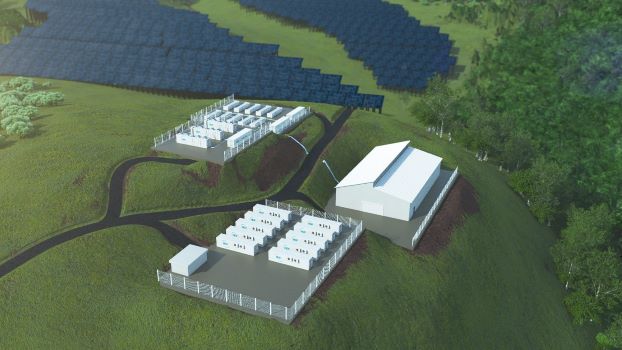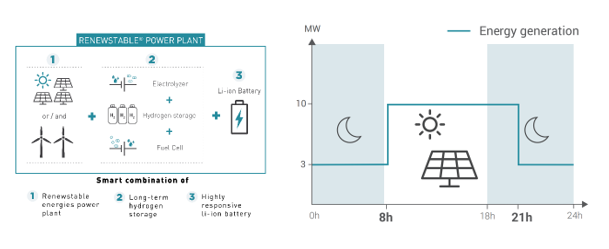Green hydrogen
HDF Energy - French Guiana / Indonesia
|
Basic description Renewable electricity is the cheapest source of power supply today, but the variability of wind and solar energy impedes the integration of higher shares into the power mix. To overcome this issue, HDF Energy has developed the Renewstable concept combining variable renewable energy, batteries, hydrogen storage and fuel cells to provide stable electricity supply. Two of the first Renewstable projects are CEOG in French Guiana and Sumba in Indonesia. These projects are expected to be commissioned in 2024 and 2025 respectively, following a staggered approach to gradually increase capacity. The CEOG project is located at Saint-Laurent du Maroni in French Guiana, where land preparation and construction started in September 2021. Although French Guiana is a continental country, its grid is similar to an isolated island grid, as it is not connected to neighbouring areas and has a limited total capacity of 450 megawatts (MW). The CEOG project aims to deliver 10 MW during daytime and 3 MW at night with an installed capacity of 55 MW of solar photovoltaic (PV), complemented by 130 megawatt-hour (MWh) energy storage capacity comprising 16 MW alkaline electrolysers and 3 MW of fuel cells. Around 600 tonnes of green hydrogen will be produced every year for this project, enabling long-term (more than 5 hours) energy storage. The Sumba project follows a similar approach for a pipeline of projects to achieve more than 10 MW firm power supply. |
 |
 |
Project rationale The CEOG project contributes to French Guiana’s target of reaching 100% locally-produced renewables in the electricity mix by 2030, with wind and solar energy playing significant roles. However, the variability of these resources can cause disruptions in small electricity grids like French Guiana’s, and flexibility measures are required to integrate wind and solar energy shares greater than 10%-20%. One such flexibility measure is short- to long-term electricity storage using green hydrogen. The Sumba Island in Indonesia was selected both due to its island grid nature as well as the existence of the Sumba Iconic Island programme targeting renewables development. Expanding solar PV capacity under this programme, however, resulted in the installation of a new diesel plant in order to maintain grid stability. To reduce the fossil fuel dependency of the grid, the national government, supported by the local government, expressed interest in a Renewstable solution to achieve at least 80% grid penetration of renewables. |
Governance
HDF Energy is the main project leader and independent power producer (IPP) in the CEOG project. It has signed a power purchase agreement (PPA) with EDF SEI (French: Electricité de France, Systèmes énergétiques insulaires), a subsidiary of the French power company EDF, specialised in overseas grids.
While HDF Energy started the project as a standalone developer, it subsequently partnered with two other firms – Meridiam, a French benefit corporation, and Rubis, an international chemical storage, distribution, and sales company with a strong local footprint in French Guiana. At financial close, ownership of the CEOG project was split between Meridiam (60%), Rubis (30%), and HDF (10%). While Meridian now has a majority share, several matters still require strategic alignment and shared decision-making among the three entities. For technical development, HDF Energy further partnered with companies such as McPhy for electrolysers and Siemens Energy for engineering, procurement and construction as well as operations and maintenance.
Now, the role of HDF Energy is primarily to lead project development, although the company intends to remain a long-term investor over project lifetimes.
Business Model
The main potential markets for Renewstable are located in island grids, i.e. grids with low capacity (typically, below 1 GW) and limited or no interconnections with other grids. To avoid relying on subsidies, HDF Energy targets grids where current electricity prices are high, especially when electricity generation assets are not diversified are dependent on imported fuels, as it is the case for diesel generators.
In the case of French Guiana, the average cost of electricity generation is fairly high at around EUR 243 per MWh. Slightly more than half of the electricity production comes from hydropower, more than one-third from fossil fuels, and less than one-tenth from biomass and solar PV.
A well-priced, long-term PPA with a creditworthy off-taker is an important element of the business model. The CEOG project’s business model is based on a 25-year PPA. Although there are no standard PPA models in Indonesia, the Sumba project will rely on long-term agreements commonly used by local small-scale projects. HDF Energy promotes the use of PPAs including capacity payments[1]to implement an economically viable contracting scheme for sustainable, pilotable power production.
Enabling market conditions and investment de-risking
As the Renewstable concept is still nascent, the primary criteria for HDF to engage in a project is that the solution addresses specific issues faced in the country or region. Archipelagic countries like Indonesia and the Philippines were identified as particularly suitable candidates. Political stability of a country is also a key consideration, as is its renewable electricity production potential and local capacity to develop and operate wind and solar PV plants.
The generation of electricity from green hydrogen is still expensive compared to natural gas-fired power plants production costs, and most countries have not yet defined full-fledged hydrogen strategies or bespoke regulations. While HDF Energy’s strategy is to remain independent from specific policy support, the existence of a long-term green hydrogen vision is a major enabler, as it helps validate the contribution of Renewstable projects in building a country’s green hydrogen capacity and eventually creating a domestic market.
Another key policy enabler is the existence of high fossil fuel taxes, as this helps create a level-playing field and increase the competitiveness of HDF Energy’s solutions.
Standardising the documentation required for loan approvals is also crucial to avoid delays and additional costs in the development phase. Some banks may ask for additional documents to sanction project loans than required by the official permitting and licensing process, thus obliging project developers to carry out multiple studies to meet specific lender expectations. Developing a country platform and a mainstreamed permitting process can help clarify lender requirements. Further, a strong track record of renewable energy projects in the country will boost investor confidence, limit additional documentation requirements and thus reduce transaction costs.
Financing
The financing structure of the CEOG project included debt instruments from commercial banks (Sumimoto Mitsui Banking Corporation, BNP Paribas, Crédit Industriel et Commercial), public investment banks (French Public Investment Bank) and the French Development Agency (AFD). Many private banks have also shown interest in the project, although the proposed average debt amount was rather low, highlighting the need for diversifying funding sources and sharing risks. The CEOG financing structure was typical of infrastructure projects, with 20% equity and 80% debt financing, for a total amount of around EUR 180 million.
The Sumba project financing will use blended finance.[2] Different development agencies and international organisations, such as the German Corporation for International Cooperation (GIZ), UK FCDO MENTARI, Asian Development Bank and United Nations Development Programme, are already involved in the financing of the environmental and social assessments, pre-feasibility studies, and other related studies. Letters of intent from development banks (United States International Development Finance Corporation, Asian Development Bank) and commercial banks (BNP Paribas) highlight interest from various actors. Additionally, the project aims to secure funds from the Green Climate Fund. Financing instruments from all actors will cumulatively result in a combination of equity, loans, mezzanine debt and credit enhancement.
[1] OECD defines blended finance as the strategic use of development finance for the mobilisation of additional finance towards sustainable development in developing countries. Further information can be found on https://www.oecd.org/dac/financing-sustainable-development/blended-finance-principles/
[2] A capacity payment is a fixed revenue mechanism for electricity producers guaranteeing the availability of a given generation capacity over a given time period in the future.
Related Documents